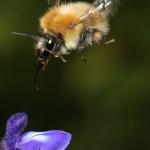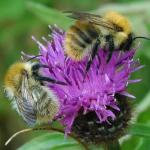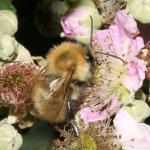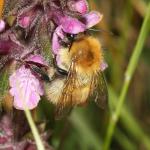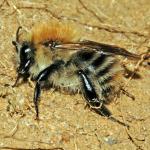One of four brown bumblebees known from the British Isles, two of which, B. muscorum and B. humilis, are declining greatly. B. pascuorum, however, although it may well be less frequent than it used to be, is currently extending its range northward, being fairly recently found on Orkney. It may be seen in a great variety of habitats and is a regular inhabitant of gardens. Identification may be very difficult in the field, unless the black patches on the sides of the abdomen are well-developed, when the specimen will definitely be this species. Pale specimens, which occur with greater frequency towards the north, require very careful examination, records being best based on males, where the form of the genitalia is diagnostic (but requiring microscopic examination).
Widely distributed throughout Britain, Ireland and the Channel Islands. Overseas: all but the more northerly areas of Europe and Asia to China. Not found in tropical and sub-tropical Asia.
A wide range of habitats are used, providing suitable pollen and nectar sources are available throughout the life of the colony.
The species is eusocial, with queens emerging from hibernation from March to June; workers are present from April onwards, and males and new females from July to October. The species may be two months later emerging in northern Scotland than in the south and these dates allow for this.
Nests are made above-ground in tall, but open grassland, under hedges and piles of plant litter. It may occasionally use bird boxes and holes in trees. It is one of the carder-bees: these bees gather moss and dry grass to make the covering of the nest. Nest sizes are fairly small, with 60-150 workers (Løken, 1973; von Hagen, 1994). The life-cycle of the nest is remarkably long, with workers still present in September and October in some cases.
Associated with flowers with longer corollae, especially Fabaceae, Scrophulariacae,
This species is attacked by the socially parasitic bee, Bombus campestris.


